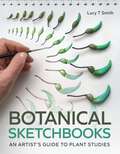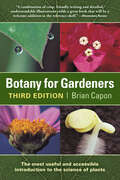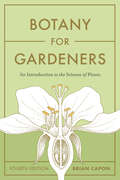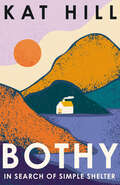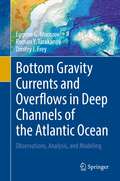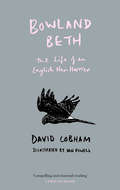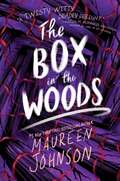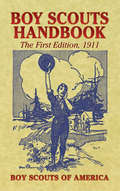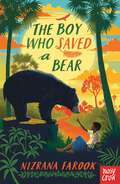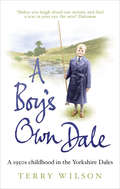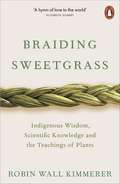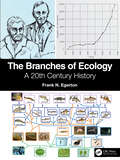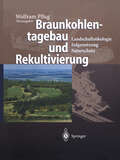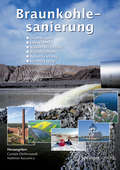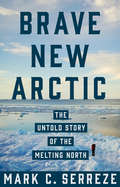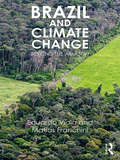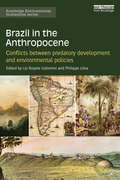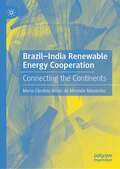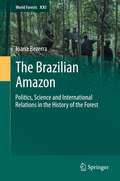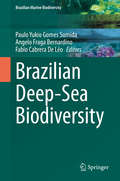- Table View
- List View
Botanical Sketchbooks: An Artist's Guide to Plant Studies
by Lucy SmithThis inspirational guide explains how a botanical sketchbook can take many forms and hold different meanings. It shows how a sketchbook can be used as a workbook to study plants through drawing and painting in a variety of media. It includes examples of preliminary work for finished pieces, experiments in colour and exploration of plant anatomy, and shows how these studies can be made away from the pressure of creating the perfect, polished piece of final botanical artwork. It goes on to feature sketchbooks created for their own sake as a curated space for an artist to draw and record plants over a period of time, or a particular place.
Botany for Gardeners
by Brian CaponThe essential overview of plant botany, perfect for both beginning and advanced gardeners.
Botany for Gardeners, Fourth Edition: An Introduction to the Science of Plants
by Brian Capon&“This should be the cornerstone of every gardener&’s library.&” —Jeff Gillman, Director of the UNC Charlotte Botanical Gardens What happens inside a seed after it is planted? How are plants structured? How do plants reproduce? The answers to these and other questions about complex plant processes can be found in the bestselling Botany for Gardeners. First published in 1990 with more than 260,000 copies sold, it has become the go-to introduction to botany for students and gardeners. Now in its fourth edition, Botany for Gardeners has been expanded and updated. It features a revised interior, with new photos and illustrations that clarify the concepts clearer than ever before. Additional updates address scientific advances, changes in nomenclature and taxonomy, and more. As before, Botany for Gardeners shares accessible information about how plants are organized, how they have adapted to nearly all environments on earth, their essential functions, and how they reproduce.
Bothy: In Search of Simple Shelter
by null Kat Hill‘The bothy embrace is addictive’ ADAM NICOLSON 'Will have you reaching for your boots’ CAL FLYN The door to the bothy is always unlocked, you just need to step inside. You will find them in the mountains. You will find them in the wilderness. A bothy is a remote hut you can’t reserve, with no electricity, mod-cons or running water. And it’s here you’ll find Kat Hill – kettle on, feet up and pen out. Leading us on a gorgeous and erudite journey around the UK, Kat reveals the history of these wild mountain shelters and the people who visit them. With a historian’s insight and a rambler’s imagination, she lends fresh consideration to the concepts of nature, wilderness and escape. All the while, Kat weaves together her story of heartbreak and new purpose with those of her fellow wanderers, past and present. Writing with warmth, wit and infectious wanderlust, Kat moves from a hut in an active military training area in the far-north of Scotland to a fairy-tale cottage in Wales. Along her travels, she explores the conflict between our desire to preserve isolated beauty and the urge to share it with others – embodied by the humble bothy. Bothy is a stirring, beautiful book for anyone who longs to run away to the wilds.
Bottom Gravity Currents and Overflows in Deep Channels of the Atlantic Ocean: Observations, Analysis, and Modeling
by Eugene G. Morozov Roman Y. Tarakanov Dmitry I. FreyThis book is dedicated to the analysis of bottom waters flows through underwater channels of the Atlantic Ocean. The study is based on recent observations of the authors, analysis of historical data, numerical modeling, and literature review. For example, studying both the measurements from the World Ocean Circulation experiment in the 1990s and recent measurements reveals the decadal variations of water properties in the ocean.Seawater is cooled at high latitudes, descends to the ocean bottom, and slowly flows to the tropical latitudes and further. This current is slow in the deep basins, but intensifies in the abyssal channels connecting the basins. The current overflows submarine topographic structures and sometimes forms deep cataracts when water descends over slopes by several hundred meters. The flow of Antarctic Bottom Water (AABW) is studied on the basis of CTD sections combined with Lowered Acoustic Doppler Profiling (LADCP) carried out annually, and long-term moored measurements of currents. This book is a collection of oceanographic data, interpretation, and analysis, which can be used by field oceanographers, specialists in numerical modeling, and students who specialize in oceanography.
Bowen's Court & Seven Winters
by Elizabeth BowenBowen's Court describes the history of one Anglo-Irish family in County Cork from the Cromwellian settlement until 1959, when Elizabeth Bowen was forced to sell the family house she loved. Bowen reviews ten generations of her family, representatives of the Protestant Irish gentry whose lives were dominated by property, lawsuits, formidable matriarchs, violent conflicts, hunting, drinking, and self-destructive fantasies.Seven Winters recalls with endearing candour Bowen's family and her Dublin childhood as seen through the eyes of a child who could not read till she was seven and who fed her imagination only on sights and sounds.
Bowland Beth: The Life Of An English Hen Harrier
by David Cobham‘An outstanding book’ Spectator The story of the short life and tragic death of Bowland Beth – an English Hen Harrier – which dramatically highlights the major issues in UK conservation.
The Box In The Woods (Truly Devious Ser. #4)
by Maureen JohnsonAfter solving the case of Truly Devious, Stevie Bell investigates her first mystery outside of Ellingham Academy in this spine-chilling and hilarious stand-alone mystery from New York Times bestselling author Maureen Johnson. Amateur sleuth Stevie Bell needs a good murder. After catching a killer at her high school, she's back at home for a normal (that means boring) summer. But then she gets a message from the owner of Sunny Pines, formerly known as Camp Wonder Falls-the site of the notorious unsolved case, the Box in the Woods Murders. Back in 1978, four camp counselors were killed in the woods outside of the town of Barlow Corners, their bodies left in a gruesome display. The new owner offers Stevie an invitation: Come to the camp and help him work on a true crime podcast about the case. Stevie agrees, as long as she can bring along her friends from Ellingham Academy. Nothing sounds better than a summer spent together, investigating old murders. But something evil still lurks in Barlow Corners. When Stevie opens the lid on this long-dormant case, she gets much more than she bargained for. The Box in the Woods will make room for more victims. This time, Stevie may not make it out alive. * Cosmopolitan Best YA Books of 2021 * People Magazine Best Books of Summer 2021*
Boy Scouts Handbook: The First Edition, 1911 (Dover Books On Americana Ser.)
by Boy Scouts of AmericaRead by presidents, scientists, and national heroes, the Boy Scouts Handbook has been used by generations of American youths. Filled with practical advice for everyone, the book contains everything from safety tips on swimming and instructions for putting up a tent to directions for making an aquarium and pointers on how to identify common North American trees.More than 200 figures and illustrations accompany valuable information on woodcrafting, camping, sailing, hiking, health and endurance, and providing first aid. But more than just a guide to outdoor life, the handbook also offers timeless observations on politeness, patriotism, and good citizenship.As useful and valid today as it was when first published nearly 100 years ago, the Boy Scouts Handbook will delight Americana enthusiasts as much as it will be treasured by collectors and nature lovers.
The Boy Who Saved a Bear
by Nizrana FarookA boy and a bear meet, become friends and have the adventure of their lives! From the author of The Girl Who Stole an Elephant comes another brilliant escapade. The fourth thrilling adventure set in a fictional Sri Lanka is jam-packed with peril, thieves and a terrifying bear! Nuwan works at the library, delivering books. One day, he accidentally takes away a very valuable key that's been hidden inside one of the books, and in the process thwarts the plans of some very dangerous thieves. On the run, he hides in a cave, only to discover in the middle of the night that he is sharing it with a big, hairy, terrifying bear! After some hair-raising moments, he and the bear reach an understanding and they travel on together, evading the bad guys and hoping the key will unlock the answers to the mystery so that they can stop running and return home... Cover and inside illustrations by David Dean.
A Boy's Own Dale: A 1950s childhood in the Yorkshire Dales
by Terry WilsonGrowing up in rural Yorkshire in the 1940s and 50s, Terry Wilson spent his school days hunting down Just William books, cutting up apples to help with fractions and staring out the window dreaming up new schemes. But it was on the Dales themselves that Terry came into his own. Whether he was 'out-fishing' the adults with his homemade rod, grouse-beating for the lady of the manor, helping to bring in the farmers' hay in exchange for rabbit shooting rights, or growing his own prize caulis, his idiosyncratic and inventive mind is only matched by his love of nature. Told with affection, dry humour and a respect for the landscape and its people, through Terry's eyes we meet farmers, mill owners and 'gentlemen of the road'. Beautifully illustrated with newly-commissioned line-drawn illustrations by Don Grant, A Boy's Own Dale is a magical memoir of a long-lost world.
Braiding Sweetgrass: Indigenous Wisdom, Scientific Knowledge and the Teachings of Plants
by Robin Wall Kimmerer'A hymn of love to the world ... A journey that is every bit as mythic as it is scientific, as sacred as it is historical, as clever as it is wise' Elizabeth Gilbert, author of Eat, Pray, LoveAs a botanist, Robin Wall Kimmerer has been trained to ask questions of nature with the tools of science. As a member of the Citizen Potawatomi Nation, she embraces the notion that plants and animals are our oldest teachers. In Braiding Sweetgrass, Kimmerer brings these two ways of knowledge together. Drawing on her life as an indigenous scientist, a mother, and a woman, Kimmerer shows how other living beings - asters and goldenrod, strawberries and squash, salamanders, algae, and sweetgrass - offer us gifts and lessons, even if we've forgotten how to hear their voices. In a rich braid of reflections that range from the creation of Turtle Island to the forces that threaten its flourishing today, she circles toward a central argument: that the awakening of a wider ecological consciousness requires the acknowledgment and celebration of our reciprocal relationship with the rest of the living world. For only when we can hear the languages of other beings will we be capable of understanding the generosity of the earth, and learn to give our own gifts in return.
The Branches of Ecology: A 20th Century History
by Frank N. EgertonThe ecological sciences are a diverse array of major scientific disciplines. They grew from minor sciences, with little status in 1900, and now occupy crucial areas of research bearing on the future of our planet. This book describes a century of growth and development. A dramatic century-long rise in the status of ecological knowledge was accompanied by the rise of professional ecological organizations, the establishment of university faculties, and the creation of government agencies advising on conservation, natural resources, and the prevention of pollution. Like all sciences, ecology continues to yield new findings and surprising revelations. New technologies now address existential challenges facing our world. This book, documenting the rise of ecology, is an inspiring history portending an important role in the twenty-first century.Key Features: The author is the acknowledged authority on the history of ecology The content is familiar to members of the Ecological Society of America but has not previously been assembled into a single narrative Appropriate for a course in the history of ecology Provides a broad perspective on ecology Related Titles:Egerton, F. N. A Centennial History of the Ecological Society of America (ISBN 978-0-3673-7763-2).Rieppel, O. Phylogenetic Systematics: Haeckel to Hennig (ISBN 978-0-3678-7645-6)Dronamraju, K. A Century of Geneticists: Mutation to Medicine (ISBN 978-1-4987-4866-7)
The Branches of Ecology: A 20th Century History
by Frank N. EgertonThe ecological sciences are a diverse array of major scientific disciplines. They grew from minor sciences, with little status in 1900, and now occupy crucial areas of research bearing on the future of our planet. This book describes a century of growth and development. A dramatic century-long rise in the status of ecological knowledge was accompanied by the rise of professional ecological organizations, the establishment of university faculties, and the creation of government agencies advising on conservation, natural resources, and the prevention of pollution. Like all sciences, ecology continues to yield new findings and surprising revelations. New technologies now address existential challenges facing our world. This book, documenting the rise of ecology, is an inspiring history portending an important role in the twenty-first century.Key Features: The author is the acknowledged authority on the history of ecology The content is familiar to members of the Ecological Society of America but has not previously been assembled into a single narrative Appropriate for a course in the history of ecology Provides a broad perspective on ecology Related Titles:Egerton, F. N. A Centennial History of the Ecological Society of America (ISBN 978-0-3673-7763-2).Rieppel, O. Phylogenetic Systematics: Haeckel to Hennig (ISBN 978-0-3678-7645-6)Dronamraju, K. A Century of Geneticists: Mutation to Medicine (ISBN 978-1-4987-4866-7)
Braunkohlentagebau und Rekultivierung: Landschaftsökologie — Folgenutzung — Naturschutz
by C. Drebenstedt E. Hildmann M. Polnik A. StürmerDas ganze Wissen in einem WerkDas Handbuch gibt Ihnen einen umfassenden Überblick über den aktuellen Stand der Rekultivierungs- und Renaturierungsmaßnahmen in den großen deutschen Braunkohlenrevieren. Sie erhalten erstmals auch einen vertiefenden Einblick in die Problematik der neuen Bundesländer. Hier stellt die Schaffung sogenannter Bergbaufolgelandschaften eine besondere Herausforderung dar.Kompetenz aus erster HandMehr als 100 Autoren aller relevanten Disziplinen aus Praxis, Forschung und Unternehmen stellen Ihnen ihre Erkenntnisse und Erfahrungen zur Verfügung. Auch Pioniere kommen zu Wort. Mit diesem Wissen sichern Sie sich eine fundierte, aktuelle Basis für Ihre eigenen Entscheidungen.Klare Orientierung in PraxisfragenAuf Ihre Praxisbelange zugeschnitten, bietet Ihnen das Handbuch den gezielten Zugriff auf die neuesten wissenschaftlichen, technischen und ökologischen Daten zur Rekultivierung und Renaturierung im deutschen Braunkohlenbergbau.- übersichtlich strukturiert- präzise, klar und verständlich- mit über 400 Abbildungen, davon 140 farbigDas Buch bietet Ihnen- einen aktuellen Überblick über Stand und Aufgaben der Rekultivierung in den großen deutschen Braunkohlenrevieren- gründliche Fallstudien durch Praktiker aus Landschaftsplanung, Forstwirtschaft, Landwirtschaft und Naturschutz- kompetente Informationen zu sensiblen Fragen der Umweltdiskussion: Landschaftsverbrauch und -wiederherstellung- Lösungsansätze auch für das Flächenrecycling außerhalb des BergbausDiese aktuelle Bestandsaufnahme sollte als zuverlässiges Nachschlagewerk griffbereit auf Ihrem Schreibtisch stehen. Bestellen Sie Ihr Exemplar am besten noch heute!
Braunkohlesanierung: Grundlagen, Geotechnik, Wasserwirtschaft, Brachflächen, Rekultivierung, Vermarktung
by Carsten Drebenstedt Mahmut KuyumcuAllein im Raum Halle/Leipzig und der Lausitz wurden etwa 30 Braunkohlentagebaue und 90 Kraftwerks- und Veredlungsstandorte seit Anfang der 1990er Jahre saniert mit dem Ziel, Umweltschäden zu beseitigen und die Landschaft wiederherzustellen. Vertreter aus Behörden und Hochschulen, Sanierungsunternehmen und Planungsbüros erläutern die eigens dafür entwickelten Technologien, sie beschreiben die Managementstrukturen und ihre Erfahrungen bei der Sanierung des stillgelegten Braunkohlenbergbaus. Mit zahlreichen Abbildungen und Tabellen sowie einem Glossar.
Brave New Arctic: The Untold Story of the Melting North (Science Essentials)
by Mark C. SerrezeAn insider account of how researchers unraveled the mystery of the thawing ArcticIn the 1990s, researchers in the Arctic noticed that floating summer sea ice had begun receding. This was accompanied by shifts in ocean circulation and unexpected changes in weather patterns throughout the world. The Arctic's perennially frozen ground, known as permafrost, was warming, and treeless tundra was being overtaken by shrubs. What was going on? Brave New Arctic is Mark Serreze's riveting firsthand account of how scientists from around the globe came together to find answers.In a sweeping tale of discovery spanning three decades, Serreze describes how puzzlement turned to concern and astonishment as researchers came to understand that the Arctic of old was quickly disappearing--with potentially devastating implications for the entire planet. Serreze is a world-renowned Arctic geographer and climatologist who has conducted fieldwork on ice caps, glaciers, sea ice, and tundra in the Canadian and Alaskan Arctic. In this must-read book, he blends invaluable insights from his own career with those of other pioneering scientists who, together, ushered in an exciting new age of Arctic exploration. Along the way, he accessibly describes the cutting-edge science that led to the alarming conclusion that the Arctic is rapidly thawing due to climate change, that humans are to blame, and that the global consequences are immense.A gripping scientific adventure story, Brave New Arctic shows how the Arctic's extraordinary transformation serves as a harbinger of things to come if we fail to meet the challenge posed by a warming Earth.
Brave New Arctic: The Untold Story of the Melting North (Science Essentials)
by Mark C. SerrezeAn insider account of how researchers unraveled the mystery of the thawing ArcticIn the 1990s, researchers in the Arctic noticed that floating summer sea ice had begun receding. This was accompanied by shifts in ocean circulation and unexpected changes in weather patterns throughout the world. The Arctic's perennially frozen ground, known as permafrost, was warming, and treeless tundra was being overtaken by shrubs. What was going on? Brave New Arctic is Mark Serreze's riveting firsthand account of how scientists from around the globe came together to find answers.In a sweeping tale of discovery spanning three decades, Serreze describes how puzzlement turned to concern and astonishment as researchers came to understand that the Arctic of old was quickly disappearing--with potentially devastating implications for the entire planet. Serreze is a world-renowned Arctic geographer and climatologist who has conducted fieldwork on ice caps, glaciers, sea ice, and tundra in the Canadian and Alaskan Arctic. In this must-read book, he blends invaluable insights from his own career with those of other pioneering scientists who, together, ushered in an exciting new age of Arctic exploration. Along the way, he accessibly describes the cutting-edge science that led to the alarming conclusion that the Arctic is rapidly thawing due to climate change, that humans are to blame, and that the global consequences are immense.A gripping scientific adventure story, Brave New Arctic shows how the Arctic's extraordinary transformation serves as a harbinger of things to come if we fail to meet the challenge posed by a warming Earth.
Brave New Arctic: The Untold Story of the Melting North (Science Essentials)
by Mark C. SerrezeAn insider account of how researchers unraveled the mystery of the thawing ArcticIn the 1990s, researchers in the Arctic noticed that floating summer sea ice had begun receding. This was accompanied by shifts in ocean circulation and unexpected changes in weather patterns throughout the world. The Arctic's perennially frozen ground, known as permafrost, was warming, and treeless tundra was being overtaken by shrubs. What was going on? Brave New Arctic is Mark Serreze's riveting firsthand account of how scientists from around the globe came together to find answers.In a sweeping tale of discovery spanning three decades, Serreze describes how puzzlement turned to concern and astonishment as researchers came to understand that the Arctic of old was quickly disappearing--with potentially devastating implications for the entire planet. Serreze is a world-renowned Arctic geographer and climatologist who has conducted fieldwork on ice caps, glaciers, sea ice, and tundra in the Canadian and Alaskan Arctic. In this must-read book, he blends invaluable insights from his own career with those of other pioneering scientists who, together, ushered in an exciting new age of Arctic exploration. Along the way, he accessibly describes the cutting-edge science that led to the alarming conclusion that the Arctic is rapidly thawing due to climate change, that humans are to blame, and that the global consequences are immense.A gripping scientific adventure story, Brave New Arctic shows how the Arctic's extraordinary transformation serves as a harbinger of things to come if we fail to meet the challenge posed by a warming Earth.
Brazil and Climate Change: Beyond the Amazon
by Viola Eduardo Matías FranchiniClimate change is increasingly a part of the human experience. As the problem worsens, the cooperative dilemma that the issue carries has become evident: climate change is a complex problem that systematically gets insufficient answers from the international system. This book offers an assessment of Brazil’s role in the global political economy of climate change. The authors, Eduardo Viola and Matías Franchini expertly review and answer the most common and widely cited questions on whether and in which way Brazil is aggravating or mitigating the climate crisis, including: Is it the benign, cooperative, environmental power that the Brazilian government claims it is? Why was it possible to dramatically reduce deforestation in the Amazon (2005-2010) and, more recently, was there a partial reversion? The book provides an accessible—and much needed—introduction to all those studying the challenges of the international system in the Anthropocene. Through a thorough analysis of Brazil in perspective vis a vis other emerging countries, this book provides an engaging introduction and up to date assessment of the climate reality of Brazil and a framework to analyze the climate performance of major economies, both on emission trajectory and policy profile: the climate commitment approach. Brazil and Climate Change is essential reading for all students of Environmental Studies, Latin American Studies, International Relations and Comparative Politics.
Brazil in the Anthropocene: Conflicts between predatory development and environmental policies (Routledge Environmental Humanities)
by Liz-Rejane Issberner Philippe LénaBrazil is considered one of the world’s most important environmental powers. With a continental territory containing almost 70 per cent of the Amazon rainforest, along with a rich biodiversity and huge amount of natural resources, its geopolitical role in environmental decisions is crucial to ongoing global negotiations surrounding climate change. Development policies based on extraction and exportation of raw materials by the mining and agribusiness sectors threaten the global environmental balance and the long-term sustainability of Brazil’s economy. Brazil in the Anthropocene examines Brazil's role within the global ecological crisis and considers how national and international policy is influenced by the interdependence of social, political, ethical, scientific and economic factors in the modern age. With chapters from a diverse range of international scholars this interdisciplinary volume will be of great interest to students and scholars of environmental politics, environmental sociology and the environmental humanities.
Brazil in the Anthropocene: Conflicts between predatory development and environmental policies (Routledge Environmental Humanities)
by Liz-Rejane Issberner Philippe LénaBrazil is considered one of the world’s most important environmental powers. With a continental territory containing almost 70 per cent of the Amazon rainforest, along with a rich biodiversity and huge amount of natural resources, its geopolitical role in environmental decisions is crucial to ongoing global negotiations surrounding climate change. Development policies based on extraction and exportation of raw materials by the mining and agribusiness sectors threaten the global environmental balance and the long-term sustainability of Brazil’s economy. Brazil in the Anthropocene examines Brazil's role within the global ecological crisis and considers how national and international policy is influenced by the interdependence of social, political, ethical, scientific and economic factors in the modern age. With chapters from a diverse range of international scholars this interdisciplinary volume will be of great interest to students and scholars of environmental politics, environmental sociology and the environmental humanities.
Brazil-India Renewable Energy Cooperation: Connecting the Continents
by Maria Cândida Arrais de Miranda MousinhoThe book is a study of the cooperation of Brazil and India on renewable energy. It is based on a research project on the energy sector of both the countries. It discusses the agreements in the energy sector between the two countries and the renewable energy policies developed in four decades. A scientific and technological mapping, a brief study of competitiveness and a primary research were carried out in order to find out the weaknesses and the opportunities for cooperation in renewable energies. This Publication will undoubtedly provoke the reader to reflect on the importance of cooperation given the growing protectionism not only in terms of energy security, but also in terms of investments in new technologies considering energy transition scenario. For Brazil and India, intensifying the dialogue is more than a strategy of visibility and the search for greater space in worldwide geopolitics.
The Brazilian Amazon: Politics, Science and International Relations in the History of the Forest (World Forests #21)
by Joana BezerraThe aim of this book is to analyse the current development scenario in the Amazon, using Terra Preta de Índio as a case study. To do so it is necessary to go back in time, both in the national and international sphere, through the second half of the last century to analyse its trajectory. It will be equally important analyse the current issues regarding the Amazon – sustainable development and climate change – and how they still reproduce some of the problems that marked the history of the forest, such as the absence of Amazonian dark earths as a relevant theme to the Amazon.In a world in which the environment gains each time more space in the national and international political agenda, the Amazon stands out. Known around the world for its richness, the South-American forest is the target of different visions, often contradictory ones, and it plays with everyone’s imagination. This is where the terra preta de índio – Amazonian Dark Earths - are found, a fertile soil horizon with high concentrations of carbon with anthropic origins, which has generated great interest from the scientific community. Studies on these soils and their so singular characteristics have triggered crucial discussions on the past, present and the future of the entire Amazon region. Despite its singular characteristics, the importance of Amazonian Dark Earths – and a history of a more productive and populated Amazon – was hidden since its discovery around 1880 until 1980, when it is possible to identify the beginning of an increase in the number of research on these soil horizons. These hundred years between the first records and the beginning of the increase in the interest around these soils witnessed structural changes both in the national arena, with the military dictatorship and a change in the place of the Amazon within internal affairs, and in the international arena with changes that reshaped the role of the environment in the political and scientific agendas and the role of Brazil in the global context.
Brazilian Deep-Sea Biodiversity (Brazilian Marine Biodiversity)
by Paulo Yukio Gomes Sumida Angelo Fraga Bernardino Fabio Cabrera De LéoThis book presents the biodiversity of the Brazilian deep-sea and its many unique geological and biological features, as well as a review of its ecology, conservation, and future research needs. The deep-sea Brazilian margin has an incredible geological heterogeneity with numerous characteristic seafloor features, and latitudinal changes in marine productivity, oceanographic conditions and biological communities have resulted in very distinct biological assemblages at regional and bathymetric scales. It is a tremendously rich ecosystem in terms of living species, from which many well-known historical tales have originated, and with unique importance for the global climate and humanity. Nevertheless, vast areas of the Brazilian margin have been explored for fishing, oil and gas, and other commodities, likely impacting a variety of deep-sea habitats at scales and intensities yet undetermined. This book is intended for students, scholars, professionals and a wide audience interested in the deep-sea in general and, more specifically, in the South Atlantic deep-sea.
